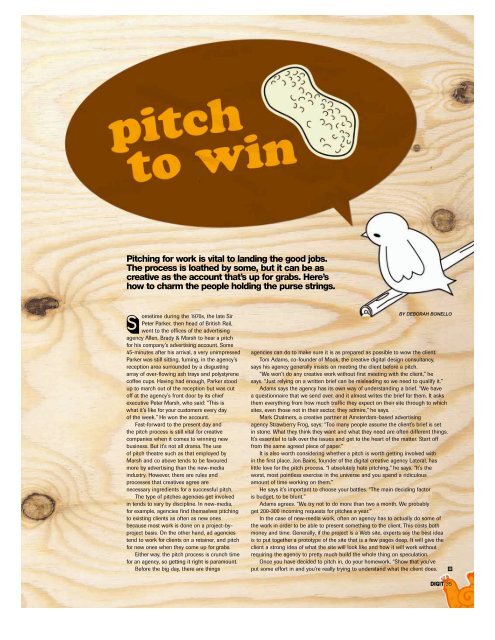You also want an ePaper? Increase the reach of your titles
YUMPU automatically turns print PDFs into web optimized ePapers that Google loves.
Pitching for work is vital to landing the good jobs.<br />
The process is loathed by some, but it can be as<br />
creative as the account that’s up for grabs. Here’s<br />
how to charm the people holding the purse strings.<br />
S<br />
ometime during the 1970s, the late Sir<br />
Peter Parker, then head of British Rail,<br />
went to the offices of the advertising<br />
agency Allen, Brady & Marsh to hear a pitch<br />
for his <strong>com</strong>pany’s advertising account. Some<br />
45-minutes after his arrival, a very unimpressed<br />
Parker was still sitting, fuming, in the agency’s<br />
reception area surrounded by a disgusting<br />
array of over-flowing ash trays and polystyrene<br />
coffee cups. Having had enough, Parker stood<br />
up to march out of the reception but was cut<br />
off at the agency’s front door by its chief<br />
executive Peter Marsh, who said: “This is<br />
what it’s like for your customers every day<br />
of the week.” He won the account.<br />
Fast-forward to the present day and<br />
the pitch process is still vital for creative<br />
<strong>com</strong>panies when it <strong>com</strong>es to winning new<br />
business. But it’s not all drama. The use<br />
of pitch theatre such as that employed by<br />
Marsh and co above tends to be favoured<br />
more by advertising than the new-media<br />
industry. However, there are rules and<br />
processes that creatives agree are<br />
necessary ingredients for a successful pitch.<br />
The type of pitches agencies get involved<br />
in tends to vary by discipline. In new-media,<br />
for example, agencies find themselves pitching<br />
to existing clients as often as new ones<br />
because most work is done on a project-byproject<br />
basis. On the other hand, ad agencies<br />
tend to work for clients on a retainer, and pitch<br />
for new ones when they <strong>com</strong>e up for grabs.<br />
Either way, the pitch process is crunch time<br />
for an agency, so getting it right is paramount.<br />
Before the big day, there are things<br />
BY DEBORAH BONELLO<br />
agencies can do to make sure it is as prepared as possible to wow the client.<br />
Tom Adams, co-founder of Mook, the creative digital design consultancy,<br />
says his agency generally insists on meeting the client before a pitch.<br />
“We won’t do any creative work without first meeting with the client,” he<br />
says. “Just relying on a written brief can be misleading so we need to qualify it.”<br />
Adams says the agency has its own way of understanding a brief. “We have<br />
a questionnaire that we send over, and it almost writes the brief for them. It asks<br />
them everything from how much traffic they expect on their site through to which<br />
sites, even those not in their sector, they admire,” he says.<br />
Mark Chalmers, a creative partner at Amsterdam-based advertising<br />
agency Strawberry Frog, says: “Too many people assume the client’s brief is set<br />
in stone. What they think they want and what they need are often different things.<br />
It’s essential to talk over the issues and get to the heart of the matter. Start off<br />
from the same agreed piece of paper.”<br />
It is also worth considering whether a pitch is worth getting involved with<br />
in the first place. Jon Bains, founder of the digital creative agency Lateral, has<br />
little love for the pitch process. “I absolutely hate pitching,” he says. “It’s the<br />
worst, most pointless exercise in the universe and you spend a ridiculous<br />
amount of time working on them.”<br />
He says it’s important to choose your battles. “The main deciding factor<br />
is budget, to be blunt.”<br />
Adams agrees. “We try not to do more than two a month. We probably<br />
get 200-300 in<strong>com</strong>ing requests for pitches a year.”<br />
In the case of new-media work, often an agency has to actually do some of<br />
the work in order to be able to present something to the client. This costs both<br />
money and time. Generally, if the project is a Web site, experts say the best idea<br />
is to put together a prototype of the site that is a few pages deep. It will give the<br />
client a strong idea of what the site will look like and how it will work without<br />
requiring the agency to pretty much build the whole thing on speculation.<br />
Once you have decided to pitch in, do your homework. “Show that you’ve<br />
put some effort in and you’re really trying to understand what the client does.<br />
d 35


